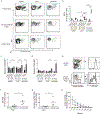Silencing of high-affinity insulin-reactive B lymphocytes by anergy and impact of the NOD genetic background in mice
- PMID: 30255377
- PMCID: PMC6219930
- DOI: 10.1007/s00125-018-4730-z
Silencing of high-affinity insulin-reactive B lymphocytes by anergy and impact of the NOD genetic background in mice
Abstract
Aims/hypothesis: Previous studies have demonstrated that high-affinity insulin-binding B cells (IBCs) silenced by anergy in healthy humans lose their anergy in islet autoantibody-positive individuals with recent-onset type 1 diabetes, and in autoantibody-negative first-degree relatives carrying certain risk alleles. Here we explore the hypothesis that IBCs are found in the immune periphery of disease-resistant C57BL/6-H2g7 mice, where, as in healthy humans, they are anergic, but that in disease-prone genetic backgrounds (NOD) they become activated and migrate to the pancreas and pancreatic lymph nodes, where they participate in the development of type 1 diabetes.
Methods: We compared the status of high-affinity IBCs in disease-resistant VH125.C57BL/6-H2g7 and disease-prone VH125.NOD mice.
Results: Consistent with findings in healthy humans, high-affinity IBCs reach the periphery in disease-resistant mice and are anergic, as indicated by a reduced expression of membrane IgM, unresponsiveness to antigen and failure to become activated or accumulate in the pancreatic lymph nodes or pancreas. In NOD mice, high-affinity IBCs reach the periphery early in life and increase in number prior to the onset of hyperglycaemia. These cells are not anergic; they become activated, produce autoantibodies and accumulate in the pancreas and pancreatic lymph nodes prior to disease development.
Conclusions/interpretation: These findings are consistent with genetic determination of the escape of high-affinity IBCs from anergy and their early contribution to the development of type 1 diabetes.
Keywords: Anergy; Autoantibodies; Autoimmunity; B cell; Diabetes; Insulin; NOD.
Conflict of interest statement
Figures





Similar articles
-
Comparative analysis of the repertoire of insulin-reactive B cells in type 1 diabetes-prone and resistant mice.Front Immunol. 2022 Oct 4;13:961209. doi: 10.3389/fimmu.2022.961209. eCollection 2022. Front Immunol. 2022. PMID: 36275764 Free PMC article.
-
Loss of B-Cell Anergy in Type 1 Diabetes Is Associated With High-Risk HLA and Non-HLA Disease Susceptibility Alleles.Diabetes. 2018 Apr;67(4):697-703. doi: 10.2337/db17-0937. Epub 2018 Jan 17. Diabetes. 2018. PMID: 29343548 Free PMC article.
-
Chronic GVH prevents anergy in bone marrow self-reactive B cells: a selective increase in post-endoplasmic reticulum processing and trafficking to the cell surface of autoreactive IgM receptors.Int Immunol. 2003 Aug;15(8):975-85. doi: 10.1093/intimm/dxg097. Int Immunol. 2003. PMID: 12882835
-
International Workshop on Lessons From Animal Models for Human Type 1 Diabetes: identification of insulin but not glutamic acid decarboxylase or IA-2 as specific autoantigens of humoral autoimmunity in nonobese diabetic mice.Diabetes. 2001 Nov;50(11):2451-8. doi: 10.2337/diabetes.50.11.2451. Diabetes. 2001. PMID: 11679421 Review.
-
B-cell anergy: from transgenic models to naturally occurring anergic B cells?Nat Rev Immunol. 2007 Aug;7(8):633-43. doi: 10.1038/nri2133. Epub 2007 Jul 20. Nat Rev Immunol. 2007. PMID: 17641666 Free PMC article. Review.
Cited by
-
Phenotypically distinct anti-insulin B cells repopulate pancreatic islets after anti-CD20 treatment in NOD mice.Diabetologia. 2019 Nov;62(11):2052-2065. doi: 10.1007/s00125-019-04974-y. Epub 2019 Aug 23. Diabetologia. 2019. PMID: 31444529 Free PMC article.
-
Techniques to Study Antigen-Specific B Cell Responses.Front Immunol. 2019 Jul 24;10:1694. doi: 10.3389/fimmu.2019.01694. eCollection 2019. Front Immunol. 2019. PMID: 31396218 Free PMC article. Review.
-
Memory B cells targeting SARS-CoV-2 spike protein and their dependence on CD4+ T cell help.Cell Rep. 2021 Jun 29;35(13):109320. doi: 10.1016/j.celrep.2021.109320. Epub 2021 Jun 11. Cell Rep. 2021. PMID: 34146478 Free PMC article.
-
Increased plasmablasts enhance T cell-mediated beta cell destruction and promote the development of type 1 diabetes.Mol Med. 2022 Feb 5;28(1):18. doi: 10.1186/s10020-022-00447-y. Mol Med. 2022. PMID: 35123388 Free PMC article.
-
Identification of an anergic BND cell-derived activated B cell population (BND2) in young-onset type 1 diabetes patients.J Exp Med. 2023 Aug 7;220(8):e20221604. doi: 10.1084/jem.20221604. Epub 2023 May 15. J Exp Med. 2023. PMID: 37184563 Free PMC article.
References
-
- Noorchashm H, Noorchashm N, Kern J, Rostami SY, Barker CF, Naji A (1997) B-cells are required for the initiation of insulitis and sialitis in nonobese diabetic mice. Diabetes 46: 941–946 - PubMed
-
- Xiu Y, Wong CP, Bouaziz JD et al. (2008) B lymphocyte depletion by CD20 monoclonal antibody prevents diabetes in nonobese diabetic mice despite isotype-specific differences in Fc gamma R effector functions. J Immunol 180: 2863–2875 - PubMed
Publication types
MeSH terms
Substances
Grants and funding
LinkOut - more resources
Full Text Sources
Other Literature Sources
Molecular Biology Databases

